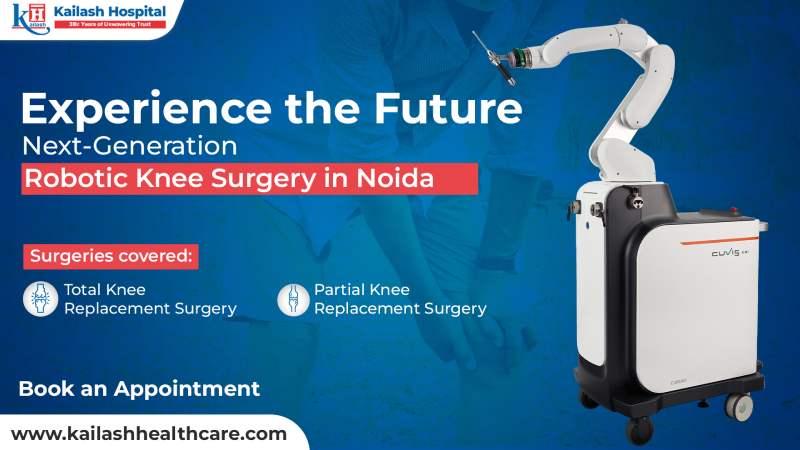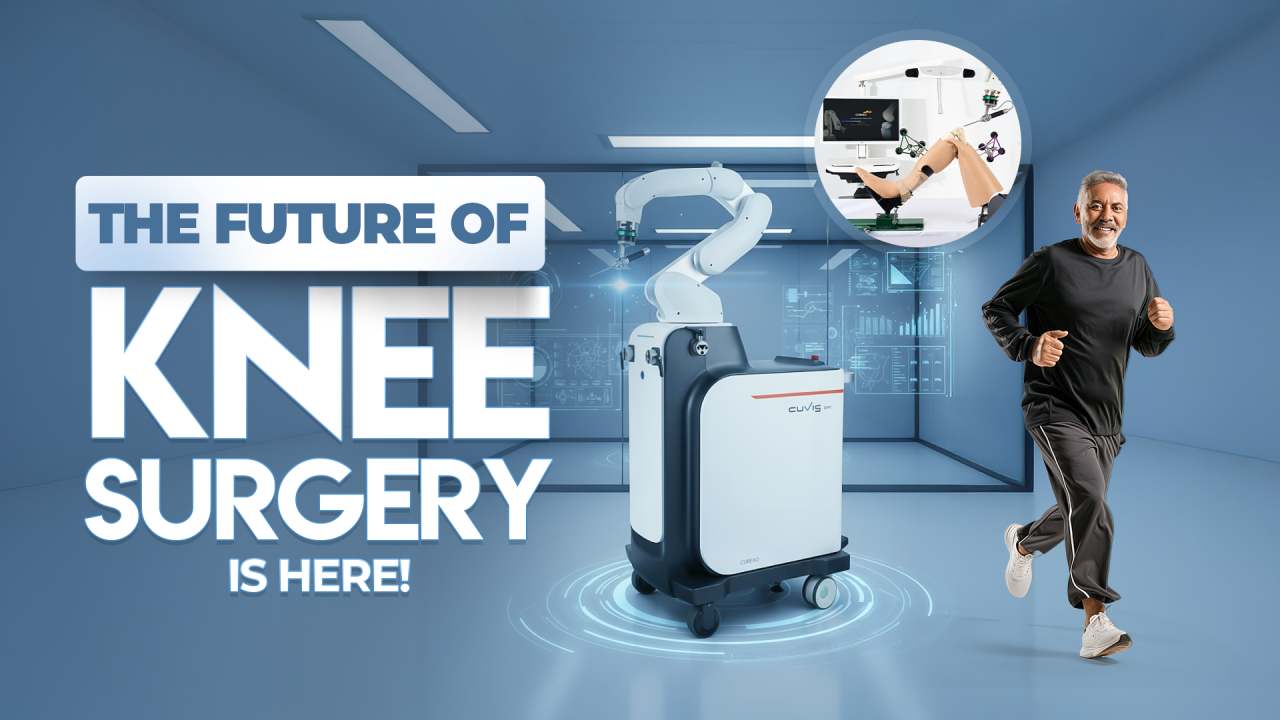List of Top Robotic Knee Replacement Surgery doctors near by
Talk to our doctors
Robotic Knee Replacement Surgery

Modern technology has revolutionized healthcare in many ways, increasing accessibility to treatment and improving outcomes. Today, surgery has become more and more minimally invasive. Robotic systems are nowadays used across the globe for an expanding set of indications. Robotic knee replacement surgery has transformed the ever-evolving field of orthopedics, helping arthritis patients recover faster, with reduced pain, less blood loss, and shorter hospital stays.
What is Robotic Knee Replacement Surgery?
Knee replacement, though complex, is commonly performed in advanced arthritis cases. Surgeons now use minimally invasive techniques, computer assistance, and robotics for greater precision. Robotic assistance ensures precise joint fixation, reducing human error.
Robotic knee replacement surgery, also known as robotic knee arthroplasty, utilizes robotic technology to assist surgeons, improving accuracy and precision. It is a minimally invasive approach with potential for better outcomes.
During the procedure, the surgeon uses computed tomography (CT) scans to create a 3D model of the patient’s knee. With this model as guide, the robotic knee replacement surgeon uses the robotic arm to make accurate bone cuts and place implant components precisely.
Types of Robotic Knee Replacement Surgery
There are two main types of robotic knee procedures:
- Partial knee replacement: In this surgery, damaged cartilage and bone are removed and replaced only in one diseased compartment of the knee. It can provide relief from pain in people with early and mid-stage arthritis.
- Total knee replacement: Advanced arthritis affecting multiple compartments of the knee requires total knee arthroplasty.
How Does Robotic Knee Surgery Benefit Patients?
Robotic knee replacement procedure has many benefits for the patient. These include:
- Minimal Pain: Robotic surgery is less invasive than traditional procedures, which can result in smaller incisions, minimal trauma, reduced risk of infection, less pain and improved safety.
- Quick Recovery: Robotic assisted knee surgery provides up to 50% faster recovery time than other procedures. This means patients can be discharged early from the hospital and resume normal activities quickly.
- Improved Quality of Life: The fully automated system allows for more accurate placement of the implant, which can result in a more natural feel and improved function of the knee.
- Enhanced Implant Longevity: Due to the high precision, knee replacement can reduce the chance of implant failure or loosening, leading to a longer-lasting implant and improved function.
Who is the Right Candidate for Robotic Knee Replacement Surgery?
To be eligible for the procedure, your doctor might consider your age, lifestyle, damage to your knee joint and other factors.
- Pain caused by arthritis usually gets worse over time. If left untreated, it can even limit your range of motion. The most appropriate and long-lasting solution to arthritis is robotic knee replacement.
- Fully automated surgery can be used to treat complex degeneration of knee joints, any deformity following an injury or repair damaged implant from previous procedures.
- Candidates for robotic surgery are typically patients with severe pain in the joints and have not responded to conservative treatments.
- Candidates with good health at a suitable age are perfect candidates for surgery. The surgeon might not recommend the surgery to people who have crossed 65 years or with arthritis that has progressed aggressively.
Preoperative Evaluation For Robotic Knee Replacement
Before undergoing robotic knee replacement surgery, patients will undergo the following medical evaluation to determine if they are a candidate for the procedure.
- Review Medical history: The orthopedics surgeon will review the patients medical history, including any previous surgeries, medications, or medical conditions, to ensure that they are a suitable candidate for surgery.
- Physical examination: The surgeon will examine the joint to assess the extent of the damage. For this, the surgeon may assess the patients knee function, range of motion, and ability to perform daily activities.
- Imaging tests: Imaging tests such as X-rays, MRI scans, or CT scans may provide detailed images of the knee joint and surrounding structures.
- Laboratory tests: Lab tests such as urinalysis, electrocardiography and blood tests may be done to assess the patients overall health.
Recovery Process Following Surgery
The recovery process after robotic knee replacement surgery can vary from person to person. However, most patients can expect to stay in the hospital for a few days following surgery and will begin physical therapy soon after to help regain strength and range of motion in the knee.
Patients will have follow-up appointments with their surgeon to monitor their progress and to address any concerns or questions they may have. It typically takes about three to six weeks to regain mobility.
Care After Knee Surgery
Some common aftercare practices include:
- Taking pain medication as prescribed by the surgeon to manage post-operative pain.
- Attending physical therapy sessions as recommended by the surgeon.
- Avoiding high-impact activities or heavy lifting for the first few weeks after surgery.Gradually increase the activity level as directed by the surgeon.
- Attending all follow-up appointments with the surgeon to monitor progress and address any concerns or questions you may have.
Is Robotic Knee Replacement Surgery Better Than Traditional Procedure?
While traditional knee replacement surgery has been a successful treatment option for many years, robotic knee surgery offers several advantages. Here are a few reasons why one might consider opting for fully automated surgery.
- Minimally invasive approach:Unlike traditional methods, robotic surgery uses a minimally invasive approach with smaller incisions.
- Enhanced surgery planning:The specialized 3D images help the surgeon more accurately plan the optimal type and placement of the artificial joint components.
- Personalized adjustments:Automated systems enable knee surgeons to create a personalized treatment plan based on the individuals specific anatomy.
- Precise positioning: The robotic arm used during the surgery allows for more precise implant placement, leading to better implant alignment, fewer complications and better long-term outcomes.
- High Accuracy:Compared to traditional methods, robotic arms have better accuracy and give a more natural feeling post surgery.
- Better Patient Outcome:Patients receiving robotic knee surgery require less rehabilitation. Also, many patients report a natural feel, improved knee function and reduced pain following the treatment.
- Increased Safety:With smaller incisions, there is less trauma to the surrounding tissues. Also, there is a potentially reduced risk of implant loosening, instability or dislocation over time as the implants are aligned carefully.
FAQ'S
The lifespan of a knee implant can vary depending on several factors, including the type of implant used, the patients activity level, and their overall health. In general, most knee implants can last 15-20 years or more.
The length of hospital stay after surgery can vary based on the extent of the surgery and how well you are recovering. In general, most patients can expect to stay in the hospital for one to three days following surgery.
Robotic knee replacement does not mean a robot is doing the surgery. A robotic arm assists the surgeon to perform the procedure with greater precision.
The duration of robotic knee replacement surgery can vary depending on the complexity of the procedure and the patients anatomy. In general, the surgery can take anywhere from one to three hours.
The timeline for returning to normal activities after surgery can vary. In general, most patients can expect to return to light activities within a few weeks and resume normal activities within a few months.
Physical therapy is an important part of the recovery process after surgery. It improves strength, flexibility, and range of motion in the knee and can help you regain function and mobility more quickly.
Related Blogs
Patient Reviews & FeedBack
© 2025 Kailash Healthcare Ltd. All Rights Reserved














